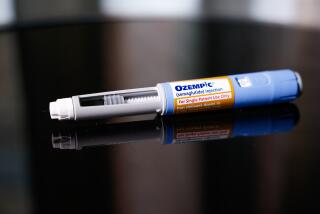Obesity gets in the way of medical imaging tests
- Share via
WASHINGTON — It’s a daily occurrence in the radiology department at Georgetown University Hospital, says Susan Ascher, director of abdominal imaging: An obese patient with belly pain on the lower right side is sent for an ultrasound. The emergency room doctor and radiologist suspect appendicitis, a diagnosis the scan could confirm. But when the radiologist moves the transducer around on the patient’s abdomen, all that’s visible, in Ascher’s words, is “a snowstorm.”
The problem is a matter of simple physics: The beam cannot penetrate the layers of fat to obtain a clear image of its target.
Instead, after a few minutes of vainly repositioning the instrument, the radiologist sends the patient back to the emergency room to await the next step, a CT scan, which it is hoped will provide a picture clear enough to make a diagnosis.
The obesity epidemic, radiologists nationwide say, increasingly is reducing their ability to diagnose and treat patients using the imaging technologies that have become a cornerstone of modern medicine: X-rays, CT scans, ultrasound and magnetic resonance imaging (MRI).
Radiologists have their own term for inconclusive tests due to obesity: “limited by body habitus,” abbreviated as LBBH. (Habitus refers to body build.) Too much fat, they say, makes it difficult or impossible to determine whether a patient has a kidney obstruction, to distinguish a benign fibroid tumor from ovarian cancer or to see whether a fetal heart is developing properly.
“There’s a lot of attention paid to the health effects of being obese, but what the general public doesn’t understand is how much it makes proper diagnosis difficult,” said Levon Nazarian, professor of radiology at Thomas Jefferson University Hospital in Philadelphia. “Every stage of an obese person’s medical care is compromised because of their size, and that includes diagnosis and treatment.”
Statistics show that about one-third of American adults are overweight, and another third are obese, weighing about 30 pounds more than their ideal weight. One in 50 adults is morbidly obese, defined as at least 100 pounds overweight.
Elmar Merkle, an associate professor of radiology at Duke University, said the problem of inconclusive imaging tests resulting from obesity “has just exploded in the past 10 years.” Ironically, Merkle said, though imaging technology has never been better, doctors are sometimes faced with the stark choice that is a throwback to an earlier era: Observe to see if the patient gets worse, or operate to find the source of the problem. Both options have potentially significant risks, doctors say.
Although the effect of obesity on imaging tests is a frequent topic of discussion among radiologists, few studies have examined the problem.
A report by researchers at the University of Washington School of Medicine published earlier this year in the Archives of Internal Medicine examined findings from 100,000 mammograms. It found that obese women had a 20% greater risk of a false-positive reading than women who were at normal weight or thin.
Two weeks ago at the annual meeting of the Radiological Society of North America, Raul Uppot, a fellow in abdominal imaging and interventional radiology at Massachusetts General Hospital in Boston, presented a study documenting the effect of obesity at the Harvard teaching hospital. Uppot and his colleagues examined 15 years of tests and found that between 1989 and 2003, the number deemed inconclusive because of obesity almost doubled, from 0.1% to 0.19%. That correlates to the increase in obesity in Massachusetts, which rose from 9% in 1991 to 16% in 2001, he said.
Equipment manufacturers, he said, need to consider design changes to cope with “America’s fattening population.”
Medical device companies say they’re doing just that to cope with a projected increase in the number of obese patients in the next decade. By 2010, if present trends continue, 50% of Americans could be classified as obese.
Siemens Medical Solutions has recently rolled out a new MRI with a wider opening and has devised an ultrasound system capable of greater depth penetration for what it delicately deems “the technically difficult patient.”
Each imaging technology has its own obesity-related limitations, Uppot noted.
In the Massachusetts General Hospital study, the test most frequently compromised by excess flab was abdominal ultrasound, used to diagnose appendicitis, gallbladder disease and kidney problems. Because it does not involve radiation, as do X-rays and CT scans, ultrasound also is widely used in obstetrics.
Conventional X-rays such as chest X-rays, used to detect tuberculosis, pneumonia and lung cancer, may be unable to penetrate layers of fat well enough to get a picture, Uppot said. In other cases the large surface area that must be scanned distorts the image. The picture can be sharpened by increasing the amount of radiation, according to Murat Gungor, an official in Siemens’s CT division, but that isn’t regarded as an acceptable trade-off because of the cancer risk posed by radiation.
“We need the best quality image at the lowest possible dose,” he said.
CT scans are similarly affected because layers of tissue scatter the focus of the beam, Uppot said.
The chief obesity-related problem with MRI systems is the inability of some patients to fit into the opening of the machine, called the bore. Siemens’s new Espree system is an open MRI with a larger diameter of 70 centimeters (or 27 1/2 inches) and a shorter tunnel. So far, only two U.S. hospitals have the system.
Thomas Jefferson’s Nazarian said he encountered at least five patients a week whose imaging tests were deemed inconclusive because they were obese.
Last week, he said, he tried to perform a routine ultrasound on a pregnant woman who weighed about 300 pounds.
“I couldn’t even see the number of chambers of the heart or the structure of the brain or the baby’s sex, which she wanted to know,” he said. “She wanted reassurance and I couldn’t give it to her, and that was difficult.
“I didn’t want to make her feel worse, so I didn’t tell her what the problem was,” he added.
“I just said, ‘The way the baby’s lying, we’re not getting a very good look.’ ”






